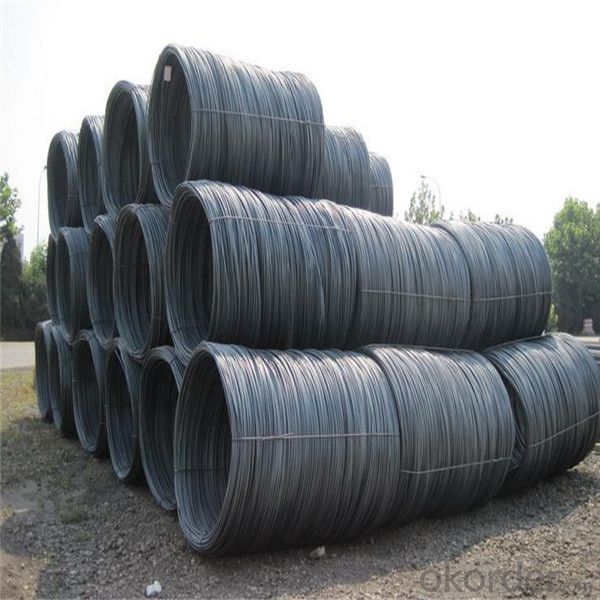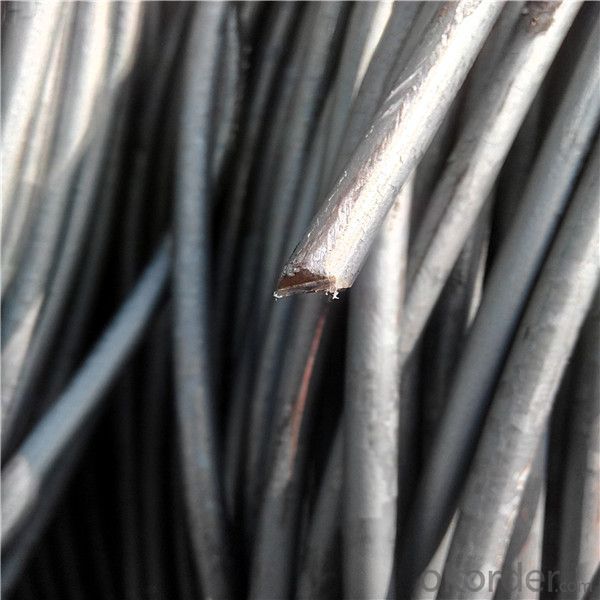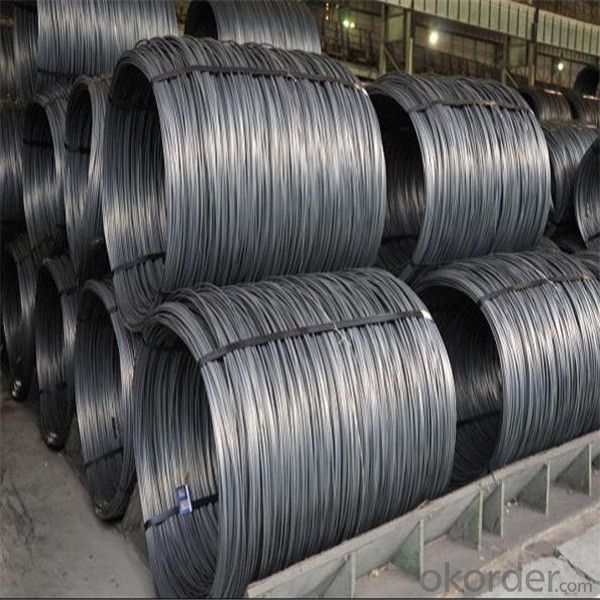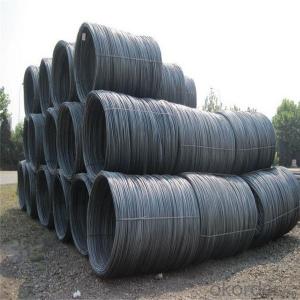Steel Wire Rod Sae 1008 from China steel mill
- Loading Port:
- Tianjin
- Payment Terms:
- TT OR LC
- Min Order Qty:
- 50 m.t.
- Supply Capability:
- 14672 m.t./month
OKorder Service Pledge
OKorder Financial Service
You Might Also Like
Item specifice
Steel wire is mainly used for prestressed and posttensioning technology in various
shapes of prestressed concrete structures,and widely used for civil engineering
construction, such as large scale railroad, highway bridges, building trusses,
overhead crane beams, industrial and prefabricated concrete floor, wall board,
tubular piles, PC water pipes, TV towers and nuclear power station, ETC. Active
strandards:GB/T5223, ASTMA421, BS5896, JISG3536, ISO6934, EN10138 or other special
required standards.
Our Advantage: High quality steel products from 1 class mills in
Reasonable price
Professionalism of the products
On-time delivery
Complete documents and certificates
Sincere service to meet our clients' requirements
Product Description :
Standard | AISI, ASTM, BS, DIN, GB, JIS |
Material/steel grade | Q195-Q235,SAE1006B,SAE1006CR, SAE1008B, SAE1008CR, SAE1010B, SAE1018B, or according to customers requirements |
Wire Gauge | 5.5-12mm |
Coil weight | 1.8-2.1mts |
MOQ | 25MT |
Delivery Time | 15-30 days after receipt of L/C or deposit by T/T |
Packing | In coil and load in container, if large quantity, by bulk vessel; Can be packed as customers' special requirements |
Payment terms | 1).100% irrevocable L/C at sight. 2).30% T/T prepaid and the balance against the copy of B/L. 3).30% T/T prepaid and the balance against L/C |
Application | widely used in machinery parts, manufacturing industry, electronics industry, metal tools and others |



Application :
It generally used in braiding the hose for bathing product and machinery. With it
good flexibility, resistant to high temperature and resistant to corrosion, it
used widely in many industries.
Packing :
Hot-rolled wire rod is held in a unit with at least four steel straps in the
transverse direction and transported and stored without further packaging.
Before
the steel strapping is applied, the wire rod must be sufficiently compressed.
The strapping is fixed in the transverse direction with a single circumferential
strap so that the strapping does not slip and cause the coil to come apart.


Our service:
(1) We cooperate with famous factories with advanced equipment and well trained workers.
(2) We can provide factory price with trading company service.
(3) We continuously work on the improvement of our processes, guaranteeing
consistently high standards of quality to keep none compensation.
(4) We guarantee 24 hours response and 48 hours solution providing service.
(5) We accept small order quantity before formal cooperation.
(6) We deliver the agreed quality at the agreed time, reacting to changes in
customer wishes in a flexible way.
(7) Due to our volume and selling power, we have excellent freight rates with
shipping lines.
(8) We strive to always be fair and honest in our dealings with customers.
(9) We strive to work together with customers to achieve much more than we can
achieve alone.
(10) Through our passion and commitment we aim to be a market leader in all our
key markets. To maintain our position as market leader we must continue to add
value in all that we do.
FAQ:
1.Q: What's your MOQ(minimum order quantity)?
A: One full container, mixed acceptable .
2. Q: What's your packing methods?
A: Packed in bundle or bulk ..
3. Q: How can I buy CNBM products in my country?
A:Please send us an inquiry or email ,we will reply to you if there is distributor in your country
4. Q: Can we visit your factory?
A: Warmly welcome. Once we have your schedule, we will arrange the
professional sales team to follow up your case.
5. Q: How long does it take to get the product if i place an order?
A:With the process of your requirements,we will pack and deliver in 3
-7 days. If it is by sea shipment,it will take 15-45 days depending on different locations
- Q:What are the common applications of oil tempered and quenched steel wire rod?
- Oil tempered and quenched steel wire rod is commonly used in various applications due to its unique properties. Here are some of the common applications: 1. Springs: Oil tempered and quenched steel wire rod is extensively used in the manufacturing of springs, especially those that require high strength and durability. It provides excellent resistance to fatigue, allowing the springs to withstand repeated loading and unloading cycles without failure. 2. Mechanical parts: The high tensile strength and toughness of oil tempered and quenched steel wire rod make it suitable for various mechanical parts that require reliability and resistance to wear and tear. These parts can include bearings, gears, shafts, and other components in machinery and equipment. 3. Automotive industry: Oil tempered and quenched steel wire rod is widely employed in the automotive industry for various applications. It is used in the production of suspension springs, valve springs, clutch springs, and other components that require both strength and elasticity. 4. Construction industry: Due to its high strength and resistance to corrosion, oil tempered and quenched steel wire rod finds applications in the construction industry. It is commonly used for reinforcing concrete structures, such as pre-stressed concrete beams and columns, as well as for manufacturing various types of wire mesh and fencing. 5. Wire ropes and cables: Oil tempered and quenched steel wire rod is often used as the core material in wire ropes and cables. The unique combination of strength, flexibility, and resistance to fatigue makes it ideal for applications that involve heavy lifting, towing, or suspension, such as cranes, elevators, and suspension bridges. 6. Oil and gas industry: The oil and gas industry relies on oil tempered and quenched steel wire rod for various applications. It is used in the manufacturing of downhole tools, such as drill pipes and sucker rods, as well as for wirelines and control cables that are crucial for exploration and production operations. In summary, oil tempered and quenched steel wire rod is versatile and finds applications in a wide range of industries. Its strength, durability, and resistance to fatigue and corrosion make it a preferred choice for springs, mechanical parts, automotive components, construction materials, wire ropes, and various oil and gas industry applications.
- Q:What are the potential risks and hazards associated with handling steel wire rod?
- The potential risks and hazards associated with handling steel wire rod include the risk of cuts and abrasions due to sharp edges or protruding wires. There is also a risk of musculoskeletal injuries from lifting heavy rods or improper manual handling techniques. Additionally, exposure to steel dust or fumes during cutting or welding processes can pose respiratory hazards. It is important to wear appropriate personal protective equipment, follow proper handling procedures, and receive training to mitigate these risks.
- Q:What are the main factors influencing the choice of steel wire rod order frequency?
- There are several key factors that influence the choice of steel wire rod order frequency. 1. Demand and market conditions: The current demand for steel wire rods in the market plays a significant role in determining the order frequency. If there is a high demand for steel wire rods, companies may need to place more frequent orders to meet customer requirements and maintain inventory levels. Additionally, market conditions such as price fluctuations and availability of supply can also influence the order frequency. 2. Production capacity and lead time: The production capacity of the steel wire rod supplier and the lead time required to deliver the orders can impact the order frequency. If a supplier has limited production capacity or a longer lead time, companies may need to place larger and less frequent orders to ensure a continuous supply of steel wire rods. 3. Inventory management: The existing inventory levels and storage capacity of the company also affect the order frequency. If a company has limited storage space or wants to minimize inventory holding costs, they may choose to place more frequent orders in smaller quantities rather than large bulk orders. 4. Cost considerations: The cost of steel wire rods, including the purchase price, transportation, and any applicable taxes or duties, is another significant factor influencing the order frequency. Companies may analyze the cost of holding inventory versus the cost of frequent ordering to determine the most cost-effective approach. 5. Supplier relationships: The relationship between the company and the steel wire rod supplier can impact the order frequency. If there is a strong and reliable partnership, companies may have more flexibility in adjusting the order frequency based on changing market conditions or business needs. Overall, the main factors influencing the choice of steel wire rod order frequency are demand and market conditions, production capacity and lead time, inventory management, cost considerations, and supplier relationships. Companies need to consider these factors in their decision-making process to ensure a steady and efficient supply of steel wire rods.
- Q:How are steel wire rods used in the construction of bridges?
- Steel wire rods serve various purposes in the construction of bridges. One common application is their use as reinforcement in concrete structures. Referred to as rebars, these steel wire rods are placed inside the concrete to enhance the bridge's durability and provide tensile strength. This is crucial as bridges must endure heavy loads, harsh weather, and potential seismic events. Additionally, suspension bridges also utilize steel wire rods. In these bridges, the primary load-bearing component is the cables, which are usually made from tightly wound strands of steel wire rods. The high tensile strength of these rods allows the cables to support the bridge deck's weight, ensuring its stability and safety. Furthermore, steel wire rods are employed in the fabrication of bridge cables for cable-stayed bridges. In this type of bridge, the cables are attached to the deck and anchored to the ground or supporting towers. The steel wire rods are arranged in a specific pattern to form the cable system, providing the necessary strength and stability to the bridge. These cables are essential for transmitting the loads from the bridge deck to the supporting elements, enabling the bridge to span long distances. In summary, steel wire rods are vital in bridge construction, providing reinforcement, enhancing tensile strength, and forming load-bearing cables. Their durability and ability to withstand heavy loads make them an ideal choice for ensuring the structural integrity and longevity of bridges.
- Q:What are the main factors influencing the choice of steel wire rod packaging?
- When selecting packaging for steel wire rods, various factors come into play. These factors encompass the need for protection, transportation requirements, handling considerations, and storage demands. Protection is a major factor to be taken into account. Steel wire rods are vulnerable to damage caused by external elements like moisture, dirt, and corrosion. Consequently, the packaging must offer ample protection against these factors to ensure the product's quality and integrity. This might entail utilizing moisture-resistant materials such as plastic or coated paper and implementing measures to prevent rust and corrosion, such as applying anti-corrosion coatings. Transportation considerations also play a vital role in determining the appropriate packaging. Steel wire rods often undergo long-distance transportation via road, rail, or sea. The packaging needs to be robust enough to withstand the challenges of transportation, including potential impacts and vibrations. Additionally, it should be designed to facilitate easy loading and unloading, while minimizing the risk of damage during handling and transportation. The choice of packaging is also influenced by the storage requirements of steel wire rods. Depending on the storage conditions, whether indoor or outdoor, the packaging may need to provide additional protection against factors like sunlight, extreme temperatures, and humidity. Furthermore, stackability is important to optimize space utilization and prevent any deformation or bending of the wire rods. Other factors that may influence the selection of steel wire rod packaging include cost-effectiveness, sustainability, and compliance with regulations. Companies must consider the cost of packaging materials, their availability, and the overall packaging process to ensure alignment with their budget and operational efficiency. In addition, there is a growing emphasis on sustainable packaging solutions that minimize environmental impact, such as using recyclable materials or reducing overall packaging waste. Compliance with industry standards and regulations, including safety and labeling requirements, is also a significant consideration in choosing steel wire rod packaging.
- Q:How is steel wire rod used in the manufacturing of wire for musical instruments?
- Steel wire rod is an essential component in the manufacturing of wire for musical instruments. It serves as the raw material that is drawn and shaped to create thin, high-quality wires used in various instruments such as guitars, pianos, and violins. The steel wire rod's strength and durability make it ideal for producing strings with excellent sound clarity and resonance. Additionally, its flexibility allows for precise tuning and responsiveness, ensuring the instrument produces the desired musical tones.
- Q:What are the common production processes for molybdenum-coated steel wire rod?
- The common production processes for molybdenum-coated steel wire rod include cleaning and surface preparation, coating deposition through methods like electroplating or thermal spraying, and final finishing processes such as annealing and coating thickness control.
- Q:What are the different types of steel wire rod drawing machines?
- There are several different types of steel wire rod drawing machines used in the manufacturing industry. Some of the most commonly used machines include: 1. Single Block Drawing Machine: This is the simplest type of wire rod drawing machine. It consists of a single block through which the wire rod is passed multiple times to reduce its diameter. This machine is ideal for drawing thin wires with high precision. 2. Double Block Drawing Machine: As the name suggests, this machine consists of two blocks through which the wire rod is passed. The wire rod is first passed through the first block to reduce its diameter, and then it is passed through the second block to further reduce the diameter. This machine is commonly used for drawing medium-sized wires. 3. Multi Block Drawing Machine: This type of machine consists of multiple blocks through which the wire rod is passed in a sequential manner. Each block reduces the diameter of the wire rod, resulting in a more precise and uniform wire. Multi block drawing machines are often used for drawing thicker wires. 4. Bull Block Drawing Machine: This machine is specifically designed for drawing large diameter wire rods. It uses a rotating bull block with grooves to reduce the diameter of the wire. The wire rod is pulled through the rotating block, which applies pressure and friction to the wire to reduce its diameter. 5. Continuous Drawing Machine: This is a highly automated machine that continuously draws the wire rod to reduce its diameter. The wire rod is fed into the machine, and it passes through a series of blocks or dies that progressively reduce its diameter. Continuous drawing machines are commonly used for mass production of wires. These are just a few examples of the different types of steel wire rod drawing machines available in the industry. The choice of machine depends on the specific requirements of the wire being produced, such as diameter, precision, and production volume.
- Q:What are the different types of steel wire rod annealing furnaces?
- The industry commonly utilizes several different types of steel wire rod annealing furnaces. These furnaces serve the purpose of heating the wire rod to a specific temperature and gradually cooling it to improve its mechanical properties and minimize internal stresses. One example of an annealing furnace is the bell-type furnace, which consists of a cylindrical chamber with a movable cover or bell that seals the chamber during the annealing process. By utilizing electric heating elements or gas burners, the wire rod is heated to the desired temperature. This type of furnace is renowned for its efficient heat transfer and uniform temperature distribution, making it suitable for annealing large quantities of wire rod. Another type of annealing furnace is the pit furnace, which is constructed underground or in a pit and has a series of burners or heating elements positioned around the chamber. The wire rod is placed on trays or fixtures and loaded into the furnace for annealing. This furnace is commonly used for annealing smaller batches of wire rod and is recognized for its energy efficiency and versatility. Continuous annealing furnaces are also extensively employed in the wire rod industry. These furnaces feature a series of heating and cooling zones that enable continuous feeding of the wire rod for annealing. The wire rod is heated to the desired temperature and then cooled down using water or air jets. Continuous annealing furnaces are distinguished by their high production capacity and ability to anneal wire rod of various sizes and shapes. Additionally, there are specialized annealing furnaces such as roller hearth furnaces, walking beam furnaces, and rotary hearth furnaces. Each of these furnaces possesses unique designs and operational characteristics tailored for specific applications in the wire rod industry. Ultimately, the selection of an annealing furnace depends on factors such as production requirements, wire rod specifications, and cost considerations. It is crucial to choose the appropriate furnace type to ensure optimal annealing results and maximize the quality of the wire rod produced.
- Q:How are steel wire rods used in the production of wire hangers for hanging clothes?
- Steel wire rods are an essential component in the production of wire hangers for hanging clothes. These rods are typically made from high-quality, durable steel, which provides the necessary strength and rigidity to support the weight of garments. The first step in the production process involves cutting the steel wire rods into the desired length for the hangers. This can be done using specialized machinery or through manual cutting methods. Once the rods are cut, they are then bent into the familiar hanger shape, typically using a combination of automated bending machines and skilled workers. The steel wire rods are manipulated and shaped to form the top hook of the hanger, which allows it to be hung on a closet rod or other hanging mechanisms. Additionally, the rods are bent to form the curved body of the hanger, which provides a secure and stable structure for hanging clothes. After the basic shape of the hanger is formed, the steel wire rods may undergo additional processes to improve their functionality and aesthetics. This may include coating the rods with a layer of protective material, such as plastic or vinyl, to prevent rusting and provide a smooth surface for hanging delicate fabrics. The hangers can also be painted or coated with a variety of colors or finishes to match different branding or aesthetic preferences. Overall, steel wire rods play a crucial role in the production of wire hangers for hanging clothes. Their strength, durability, and versatility make them an ideal material for creating hangers that can support a wide range of garments. Whether it's in homes, retail stores, or laundry facilities, wire hangers made from steel wire rods are a staple tool for organizing and displaying clothes.
1. Manufacturer Overview |
|
|---|---|
| Location | |
| Year Established | |
| Annual Output Value | |
| Main Markets | |
| Company Certifications | |
2. Manufacturer Certificates |
|
|---|---|
| a) Certification Name | |
| Range | |
| Reference | |
| Validity Period | |
3. Manufacturer Capability |
|
|---|---|
| a)Trade Capacity | |
| Nearest Port | |
| Export Percentage | |
| No.of Employees in Trade Department | |
| Language Spoken: | |
| b)Factory Information | |
| Factory Size: | |
| No. of Production Lines | |
| Contract Manufacturing | |
| Product Price Range | |
Send your message to us
Steel Wire Rod Sae 1008 from China steel mill
- Loading Port:
- Tianjin
- Payment Terms:
- TT OR LC
- Min Order Qty:
- 50 m.t.
- Supply Capability:
- 14672 m.t./month
OKorder Service Pledge
OKorder Financial Service
Similar products
New products
Hot products
Hot Searches
Related keywords



























